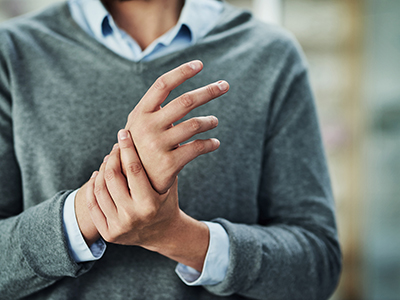Sonya M. Sloan, MD, explores how smart phones and other devices are impacting our health and what we can do about it.
We have all heard of the dangers of texting while driving, but what about texting while walking? A few years ago, while working as a traveling orthopedic surgeon in a small town, I sat at a sidewalk cafe enjoying the crisp autumn air when out of nowhere, there seemed to be a flood of people, mostly young adults, walking aimlessly around the historic town’s square. They were continuously looking down while searching for something with their smartphones. One teenager haphazardly stepped off the curb into oncoming traffic. In that instant, life was like a video in slow motion and I was witnessing what I thought to be my next operative patient. There was no doubt in my mind that I would be taking this person to emergency surgery for some open long bone fracture due to an ‘auto-ped-phone’ accident. Fortunately, the driver was more aware than the cell phone user was of his own surroundings. Later that night I saw the news explaining the newest Pokemon craze. And just in case you are like me, apparently living under the preverbal rock, Pokémon Go is an augmented reality-based game that requires players to track animated characters on their cell phones in real locations. The near miss I had witnessed earlier, of smartphone meets orthopedic trauma, now made perfect sense. The entire incident brought to my attention a very real and present danger in our society today as it relates to my profession and the implications of orthopedic injuries due to smart device usage.
The implications of growing smart phone use

The reality is smart devices are here to stay. In fact, the number of smart devices will increase and become more intertwined with our daily lives than ever before. For example, there are 6.8 billion smartphone users in the world to date. This number is increasing with tremendous speed. It is anticipated that we could possibly breach the 7 billion mark a year from now.
As a parent and orthopedic surgeon, I must admit that what is more concerning is the number of younger individuals using smartphones and devices daily for extended periods of time. The latest research reveals that 56% of children aged between 8 and 12 have a cell phone and 21% of kids who are eight or younger use a smartphone or a smart device. Here is the caveat: the number of studies and legitimate research as to the orthopedic implications and injuries for children and youth usage of smartphones and devices is just really beginning.
Now I am the first to say how much I love technology and believe that medicine and society would not be as advanced as we are without it. Nonetheless, to say technology and humans have a love/hate relationship is a huge understatement. Yes, technology is helping, advancing, and accentuating our experiences in life. But with the average American using their smart devices on average more than 4 hours a day, it suffices to say technology is curtailing our interactions while also hurting us as human beings simultaneously (a different discussion for another blog post).
The good news is that the short- and-long term effects of smart device usage is being identified more prevalently and is better documented. In fact, it is very likely and highly plausible that technology medicine or #TechMed will become a sub-specialty, identifiable in various medical fields, but specifically orthopedic surgery. Why? Likely due to the ergonomics and musculoskeletal involvement for repetitive use of smartphones and smart devices.
Technology-related injuries
So how do we, as consumers and users of smart devices, become more aware and change our dispositions to orthopedic implications and/or injuries as it pertains to technology? For this discussion I am considering all smart devices (mostly hand-held): cell phones or mobile phones, tablets, smart watches, gaming consoles, and even small laptop computers. As time goes on and technology continues to evolve, this list and the types of smart devices will grow. But for now let me make you aware of some common terms that are new for some or are considered as an a.k.a. (also known as) diagnoses to others. In 2020, the ICD-10-CM Diagnosis Code Y93.C9 can be used to describe the circumstance causing an injury, not the nature of the injury, for activity involving computer technology and electronic devices.
Here are some new additions for your medical lexicon that have been billable orthopedic diagnoses and/or digital disabilities due to repetitive use injuries and conditions:
- Tech neck (pain and inflammation in the neck as it bends forward and down)
- Tech horn (bone spur at the skull base from sustained forward head flexion)
- iPosture (neck or low back pain from leaning or crouching over devices)
- Selfie elbow (micro ruptures which cause inflammation/pain due to repetitive loading of muscles around the elbow)
- Cell phone shoulder (postural overload with pain of anterior shoulder and deltoid)
- Gamer’s, smartphone, or texting thumb (inflammation of tendons in or near base of thumb)
- Text claw (due to wrist being in fixed texting position for an extended period)
- Smartphone pinky (temporary deformity to the little finger)

There are other familiar names that would be considered the same diagnosis as some of the digital disabilities that fall under cumulative trauma disorders (CMDs) also due to prolonged, repetitive use, or postural dyskinesis:
- DeQuervain’s syndrome (inflammation of tendons in or near base of thumb)
- Carpal tunnel syndrome (compression or irritation of the median nerve)
- Cubital tunnel syndrome (ulnar neuropathy, compression or irritation of the ulnar nerve)
- Trigger finger or trigger thumb (stenosing tenosynovitis)
- Joint pain (fingers, wrist, elbow, shoulder, neck and back)
- Tendonitis of various joints (tendons and muscles become inflamed from repetitive movements)
- Degenerative Joint Disease (DJD) (wear and tear of cartilage leading to osteoarthritis)
- Herniated disc
- Neuritis (nerve inflammation or irritation)
- Myofascial pain (chronic, painful condition that affects the fascia or the connective tissue that covers the muscles)
Although smart device usage may be convenient and in vogue, it can be ergonomically dysfunctional to parts of the human body with over usage and cumulative effects. As the heightened desire and need for technology grows and hand-held smartphones and devices consume our lives, we must educate ourselves as to the best practices and postures that will limit short- and long-term damage to our bodies.
As human beings we may not be able to out-think our smartphones or devices, but as my grandmother used to say: “Use your common sense and be smart.” So the next time you or your patient says “iHurt”, my suggestion as an #OrthoDoc is to rest, stretch, reposition, limit your usage, or just don’t do that. Know when you are putting your body and your health at risk.
 Blog
Blog